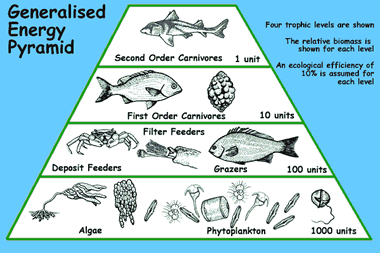Charles Elton pioneered the concept of food cycles, food chains, and food size in his classical 1927 book "Animal Ecology"; Elton's 'food cycle' was replaced by 'food web' in a subsequent ecological text. Elton organized species into functional groups, which was the basis for Raymond Lindeman's classic and landmark paper in 1942 on trophic dynamics. Lindeman emphasized the important role of decomposer organisms in a trophic system of classification. The notion of a food web has a historical foothold in the writings of Charles Darwin and his terminology, including an "entangled bank", "web of life", "web of complex relations", and in reference to the decomposition actions of earthworms he talked about "the continued movement of the particles of earth". Even earlier, in 1768 John Bruckner described nature as "one continued web of life".
Food webs are limited representations of real ecosystems as they necessarily aggregate many species into trophic species, which are functional groups of species that have the same predators and prey in a food web. Ecologists use these simplifications in quantitative (or mathematical) models of trophic dynamics. Using these models they can measure and test for generalized patterns in the structure of real food web networks. Ecologists have identified non-random properties in the topographic structure of food webs. Published examples that are used in meta analysis are of variable quality with omissions. However, the number of empirical studies on community webs is on the rise and the mathematical treatment of food webs using network theory had identified patterns that are common to all. Scaling laws, for example, predict a relationship between the topology of food web predator-prey linkages and levels of species richness.
The base or basal species in a food web are those species without prey and can include autotrophs or saprophytic detrivores (i.e., the community of decomposer's in soil, biofilms, and periphyton). Feeding connections in the web are called trophic links. The number of trophic links per consumer is a measure of food web connectance. Food chains are nested within the trophic links of food webs. Food chains are linear (noncyclic) feeding pathways that trace monophagous consumers from a base species up to the top consumer, which is usually a larger predatory carnivore.
In the simplest scheme, the first trophic level (level 1) is plants, then herbivores (level 2), and then carnivores (level 3). The trophic level is equal to one more than the chain length, which is the number of links connecting to the base. The base of the food chain (primary producers or detrivores) is set at zero. Ecologists identify feeding relations and organize species into trophic species through extensive gut content analysis of different species. The technique has been improved through the use of stable isotopes to better trace energy flow through the web. It was once thought that omnivory was rare, but recent evidence suggests otherwise. This realization has made trophic classifications more complex.

The Real Food Chain/Pyramid

Food Chains and Pyramids

The Okinawa diet food pyramid

New Animal Food Pyramids in

This pyramid helps one

Food Web and Food Chain

Food Pyramids

compose a food chain.

of the pyramid and are the

Food Chain:

The Obsolete Food Pyramid

a food chain,

carbon into the food chain

For the Woodland Creature\x26#39;s

The Asian Pyramid

A food chain may be defined as
Food webs are limited representations of real ecosystems as they necessarily aggregate many species into trophic species, which are functional groups of species that have the same predators and prey in a food web. Ecologists use these simplifications in quantitative (or mathematical) models of trophic dynamics. Using these models they can measure and test for generalized patterns in the structure of real food web networks. Ecologists have identified non-random properties in the topographic structure of food webs. Published examples that are used in meta analysis are of variable quality with omissions. However, the number of empirical studies on community webs is on the rise and the mathematical treatment of food webs using network theory had identified patterns that are common to all. Scaling laws, for example, predict a relationship between the topology of food web predator-prey linkages and levels of species richness.
The base or basal species in a food web are those species without prey and can include autotrophs or saprophytic detrivores (i.e., the community of decomposer's in soil, biofilms, and periphyton). Feeding connections in the web are called trophic links. The number of trophic links per consumer is a measure of food web connectance. Food chains are nested within the trophic links of food webs. Food chains are linear (noncyclic) feeding pathways that trace monophagous consumers from a base species up to the top consumer, which is usually a larger predatory carnivore.
In the simplest scheme, the first trophic level (level 1) is plants, then herbivores (level 2), and then carnivores (level 3). The trophic level is equal to one more than the chain length, which is the number of links connecting to the base. The base of the food chain (primary producers or detrivores) is set at zero. Ecologists identify feeding relations and organize species into trophic species through extensive gut content analysis of different species. The technique has been improved through the use of stable isotopes to better trace energy flow through the web. It was once thought that omnivory was rare, but recent evidence suggests otherwise. This realization has made trophic classifications more complex.

The Real Food Chain/Pyramid

Food Chains and Pyramids

The Okinawa diet food pyramid

New Animal Food Pyramids in

This pyramid helps one

Food Web and Food Chain

Food Pyramids

compose a food chain.

of the pyramid and are the

Food Chain:

The Obsolete Food Pyramid

a food chain,

carbon into the food chain

For the Woodland Creature\x26#39;s

The Asian Pyramid

A food chain may be defined as
No comments:
Post a Comment